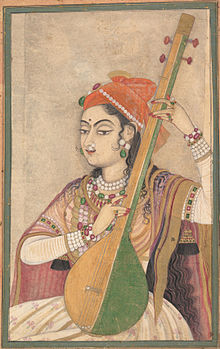Raga rock
| Raga rock | |
|---|---|
| Stylistic origins | |
| Cultural origins | Mid-1960s, United Kingdom and United States |
| Typical instruments | |
| Derivative forms | |
| Music of India | |
|---|---|

A Lady Playing the Tanpura, ca. 1735 (Rajasthan)
|
|
| Genres | |
|
|
| Media and performance | |
| Music awards | |
| Music festivals | |
| Music media | |
| Nationalistic and patriotic songs | |
| National anthem | Jana Gana Mana |
| Regional music | |
|
|
Raga rock is rock or pop music with a heavy Indian influence, either in its construction, its timbre, or its use of instrumentation, such as the sitar and tabla. More recently, scholars have included British rock music from the 1960s and 1970s that utilizes South Asian musical materials and instruments and Western ideas of South Asia.
Raga rock is not normally considered a specific genre of music, but rather a general aspect of any rock significantly influenced by Indian classical music. Since Indian influences are primarily limited to 1960s rock, most raga rock is limited to that decade, although heavily Indian-derived sounds are found in some post-1960s rock.
Ragas are specific melodic modes used in classical music of South Asia. Thus, any rock songs with obvious Indian influences may be deemed "raga-rock" although the term is frequently used to refer to much more explicitly Indian musical outings. A major influence on raga rock was the Indian classical raga music of Bengali sitarist Ravi Shankar, who himself had become a pop music icon by 1966, following the rise of the raga rock trend.
The advent of raga rock is often traced to the July 1965 release of "See My Friends", a Top 10 single for The Kinks in the UK, although The Yardbirds' "Heart Full of Soul", released the previous month, featured a sitar-like riff by guitarist Jeff Beck.The Byrds' March 1966 single "Eight Miles High" and its B-side "Why" were also influential in originating the musical subgenre. Indeed, the term "raga rock" was coined by The Byrds' publicist in the press releases for the single and was first used in print by journalist Sally Kempton in her review of "Eight Miles High" for The Village Voice. However, in his 1968 Pop Chronicles interview, Byrds member Roger McGuinn denied that "Eight Miles High" was in fact raga rock.The Paul Butterfield Blues Band further elevated the concept of Indian influenced rock music with a 13-minute instrumental titled "East-West", which became the title track of their 1966 album, East-West.
...
Wikipedia
